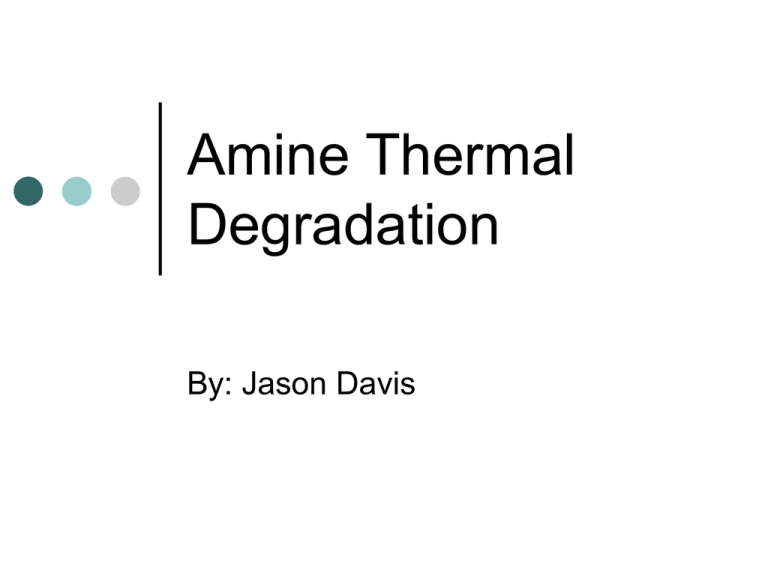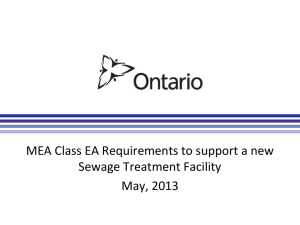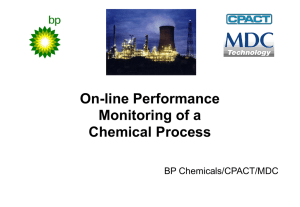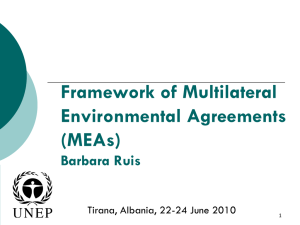3_Jason
advertisement

Amine Thermal Degradation By: Jason Davis Overview Carbamate Polymerization of MEA Background Chemistry Model PZ and MEA/PZ Blends Amine Screening Amine Losses Oxidative Degradation – A. Sexton Thermal Degradation – degradation occuring at stripper and reclaimer conditions Carbamate polymerization Other thermal degradation Volatility – M. Hilliard Physical Losses Amine Losses Vapor Losses Oxidative Degradation Thermal Degradation CO2 COLDLEAN EFFLUENT ABSORBER HOT RICH CROSSX FLUEGAS COLDRICH STRIPPER HOT LEAN RECLAIM Thermal Degradation Industry standards currently limit MEA concentration at 30wt% (15wt% being the standard for natural gas treating) due to concern over increased corrosion and thermal degradation Degradation can lead to ineffective CO2 capture, loss of expensive solvent, increased equipment corrosion, and an increased environmental impact Chemistry NH2 HO + CO2 MEA NH HO CO2- + H+ MEA Carbamate O NH HO CO2- + H+ + H2O O NH 2-Oxazolidone Polderman Dillon and Steele (1955) Chemistry - Continued O O O NH + MEA HN OH N + H2O 1-(2-hydroxyethyl)-2-imidazolidone (HEIA) O HN N OH + H2O NH HO NH2 N-(2-hydroxyethyl)-ethylenediamine (HEEDA) + CO2 What Do We Know MEA Carbamate Polymerization Factors CO2 loading Temperature Amine concentration Literature for MEA No kinetic data available Controlled when solutions held at 15 wt% in industrial applications Sample Apparatus Use high pressure sample containers made of 316L stainless steel tubing and endcaps Forced convection oven to maintain constant temperature for a large number of samples Maintains CO2 loading in solution at elevated temperature and pressure to accelerate thermal degradation Simple experimental design and allows for a large number of solutions to be tested at one time Analytical GC HPLC High temperatures can alter results Separation of polar compounds difficult and cross contamination in sample port Amine detection difficult with standard detectors Can identify and quantify nonionic species Cation IC Separates positively charged ions Will not detect non-ionic species Can measure amine disappearance and the formation of ionic species (highly polar) MEA Experiments Matrix of samples MEA Concentration (15-40wt%) CO2 Loading (0.2-0.5) o Temperature (100-150 C) 100oC and 150oC experiments in 2ml sample containers 120oC and 135oC experiments in 10ml containers o 11m MEA after 8 wks at 135 C 6.00 10172007 135C 11m Autosampler #6 [modified by TEXAS UNIVERSITY OF] µS 11m MEA a=0.5 T=135C t=8wks ECD_1 MEA 1 - MEA - 3.525 4.00 2.00 2 - Unknown 1 - 5.750 -0.50 0.0 HEEDA 3 - HEEDA - 12.150 min 1.3 2.5 3.8 5.0 6.3 7.5 8.8 10.0 11.3 12.5 13.8 15.0 16.3 17.5 18.8 20.0 Emperical Data Regression MEA f MEA o e K * 1.45 *MEAo 0.5 *t where K is the temperature dependent rate constant given by: K e 33.4 28900 /(T *1.987 ) MEAf = final MEA concentration (molality) MEAo = initial MEA concentration (molality) = Loading defined as moles CO2 per mole amine t = time (weeks) T = Temperature (K) Effect of Loading (T=135C) 11 MEA (molality) 10 =0.2 9 8 =0.4 7 6 =0.5 5 4 0 2 4 Time (wks) 6 8 Effect of Temperature (=0.4) 100oC 7 MEA (molality) 6 120oC 5 135oC 4 3 150oC 2 1 0 0 2 4 Time (wks) 6 8 Effect of Concentration o (T=135 C =0.4) 100 95 MEA Remaining (%) 90 85 80 75 7m 70 3.5m 11m 65 60 55 50 0 1 2 3 4 Time (wks) 5 6 7 8 HEEDA Formation o 11m MEA at 135 C 0.5 =0.2 0.45 HEEDA (m) 0.4 0.35 =0.4 0.3 0.25 =0.5 0.2 0.15 0.1 0.05 0 0 2 4 6 8 Thermal Degradation Costs Approximately $2/ton CO2 allocated to solvent make-up in most cost models Assumes 1.5kg MEA/ton CO2 and a cost of $1.32/kg MEA 3.5m MEA, P=1atm, $0.10/ton CO2 11m MEA, P=2.5 atm, ~$1.60/ton CO2 Does not include corrosion or reclaimer costs Natural gas processing experience says reclaimer composes 50% of thermal degradation Corrosion has been shown to increase in the presence of HEEDA MEA Conclusions Temperature has the greatest effect on thermal degradation in the stripper Quadruples every 15oC Double pressure = 15oC temp increase Loading increases degradation slightly more than 1st order Concentration has multiple effects Slightly more than 1st order in concentration In practice an increase in concentration yields increased stripper temperatures due to increased BP of solution (3.5m to 11m increases temperature by ~4oC and increases thermal degradation by 40%) MEA/PZ Blended Systems Made measurements of aqueous PZ and a 7m MEA/2m PZ blend at varying temperatures PZ not expected to degrade since it does not have an alcohol group to form an oxazolidone intermediate HN NH Unknown what the blended system would do Aqueous PZ after 8 weeks o at 150 C 5.00 7m MEA 2m PZ Tests #11 [modified by TEXAS UNIVERSITY OF] µS 2.5m PZ T=150 t>8wks ECD_1 PZ 1 - Piperazine - 13.100 3.75 2.50 These peaks are in the time 0 sample 1.25 -0.50 0.0 min 1.3 2.5 3.8 5.0 6.3 7.5 8.8 10.0 11.3 12.5 13.8 15.0 16.3 17.5 18.8 20.0 Degraded MEA/PZ after o 3 weeks at 135 C 1 - 7m MEA 2m PZ Tests #7 [modified by TEXAS UNIVERSITY OF] 7m MEA 2m PZ t=0 12.0 2 - 7m MEA 2m PZ Tests #4 [modified by TEXAS UNIVERSITY OF, 1 peak manually assigned] µS ECD_1 ECD_1 1 MEA - MEA - 3.525 Degradation Products 5.0 PZ 2 - Piperazine - 12.975 21 -1.0 0.0 min 1.3 2.5 3.8 5.0 6.3 7.5 8.8 10.0 11.3 12.5 13.8 15.0 16.3 17.5 18.8 20.0 Amine Losses after 2 Weeks Solvent Temp (oC) MEA Loss (%) PZ Loss (%) Total Amine Loss (%) Pure PZ 120 - <2.0 <2.0 Pure MEA 120 4.0 - 4.0 MEA/PZ Blend 120 5.0 8.6 6.3 Pure PZ 135 - <2.0 <2.0 Pure MEA 135 18.1 - 18.1 MEA/PZ Blend 135 11.9 31.8 19.1 *All systems have a loading of 0.4 and similar moles of alkilinity PZ Blend Conclusions PZ with a loading of 0.4 did not degrade at 150oC for over 8 weeks The blended systems preferentially destroyed PZ, the more expensive solvent PZ is a stronger nucleophile so it attacks the MEA oxazolidone structure more readily than MEA thereby increasing degradation Other Amines Set up several screening experiments on other amine systems including EDA DETA MDEA HEEDA DGA AMP Only measured ionic degradation products Amine Screening o (T=135 C =0.4 t=4wks) Amine PZ DGA Concentration Remaining Total Area (molality) Amine Peak (%) Retention (%) 3.5 100 100 7 93 98 50 wt% 71 97 AMP 3 97 96 EDA 3.5 64 91 MEA 7 76 80 DETA 2.3 9 71 HEEDA 3.5 3 17 MDEA o MDEA after 4wks at 135 C 1 - 135 Amine Screening Autosampler #11 [modified by TEXAS UNIVERSITY OF] 50wt% MDEA a=0.45 t=0 (2) 4.00 2 - 135 Amine Screening Autosampler #12 [modified by TEXAS UNIVERSITY OF, normalized] µS ECD_1 ECD_1 MDEA 1 - 4.350 3.00 2.00 1.00 21 -0.50 1.0 min 2.0 3.0 4.0 5.0 6.0 7.0 8.0 9.0 10.0 11.0 12.0 13.0 14.0 15.0 16.0 17.0 18.0 19.0 20.0 o HEEDA after 4wks at 135 C 1 - 135 Amine Screening Autosampler #3 [modified by TEXAS UNIVERSITY OF] 3.5m HEEDA a=0.45 t=0 5.50 2 - 135 Amine Screening Autosampler #4 [modified by TEXAS UNIVERSITY OF] 3.5m HEEDA a=0.45 T=135 t=4wks µS ECD_1 ECD_1 HEEDA 1 - HEEDA - 11.942 3.75 2.50 1.25 21 -0.50 0.0 min 1.3 2.5 3.8 5.0 6.3 7.5 8.8 10.0 11.3 12.5 13.8 15.0 16.3 17.5 18.8 20.0 Amine Screening Conclusions HEEDA degrades very quickly compared to other amines studied Industrially MDEA does not significantly degrade but this study shows it does shift to other amines Arm shifting Higher activation energy than other amines so increased temperature might effect more Order from least to most degradation PZ<DGA< MDEA< AMP<EDA< MEA< DETA< HEEDA Future Work Mechanistic model for MEA degradation MEA with spikes of various degradation products to determine k values for reactions Measure HEIA formation with HPLC for low temp samples to get a more accurate degradation rate Thermal Degradation modeling in ASPEN Various stripper configurations Possible reclaiming simulations as well Summary Thermal degradation can be important in the overall cost of the MEA absorber/stripper system Engineering controls can keep these costs reasonable Further study of the reclaiming system is needed PZ does not thermally degrade by itself, but does in the presence of alkanolamines Many common amines do degrade under stripper conditions and this should be considered when choosing a solvent QUESTIONS?









